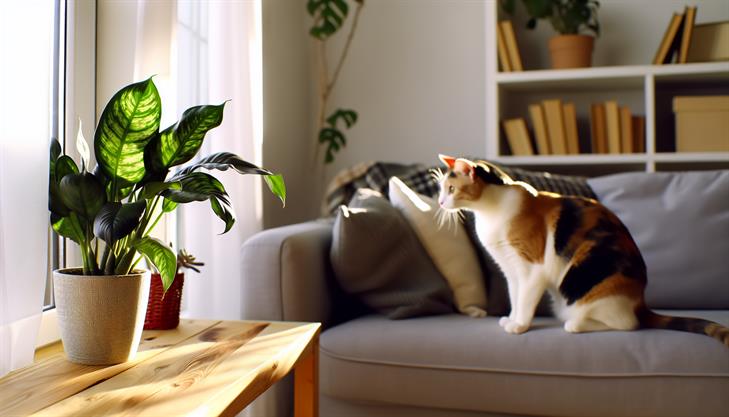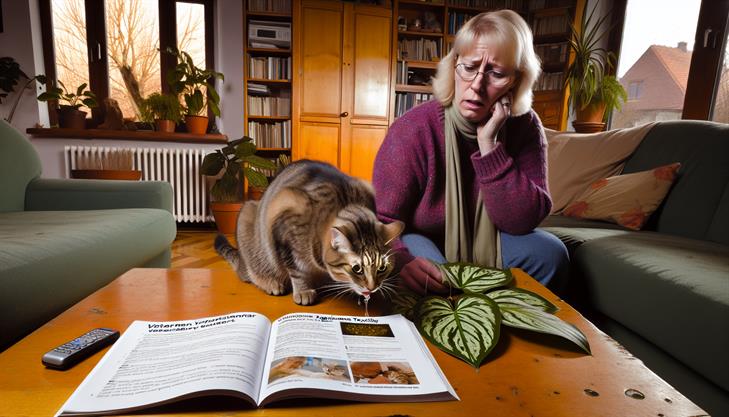If you’re a cat owner with a passion for indoor gardening, then you’ve likely encountered the stunning appeal of the Aglaonema plant—often touted for its vibrant leaves and remarkable adaptability. But as you admire its beauty, a critical question may linger: is Aglaonema toxic to cats? Understanding the potential hazards in our homes is essential for the safety and well-being of our feline friends, who are notorious for their curiosity and penchant for chewing on greens. This guide aims to unravel the truth about Aglaonema’s safety, shedding light on what every cat-loving plant enthusiast should know. By the end of this article, not only will you be armed with essential information to protect your pet, but you’ll also walk away with practical tips to keep your plant collection pet-friendly. Whether you’re a seasoned plant parent or new to the world of houseplants, this guide promises to equip you with the knowledge needed to cultivate a harmonious home for both your leafy companions and your beloved cats.
Understanding Aglaonema: What Makes It Toxic to Cats
Aglaonema, often referred to as Chinese Evergreen, is a popular houseplant known for its striking foliage and easy maintenance. However, if you’re a pet owner, particularly of cats, understanding the potential risks of having this plant in your home is crucial. To address the question, "Is Aglaonema toxic to cats?" the straightforward answer is yes. Here’s an in-depth look at why Aglaonema can be harmful and how to manage this risk effectively.
Why is Aglaonema Toxic to Cats?
Aglaonema contains calcium oxalate crystals, a compound that is insoluble and found in many plant species. These microscopic, needle-like crystals can cause irritation when ingested or when they come into contact with the skin. For cats, who are naturally curious and may nibble on plants, this can lead to a range of health issues.
Symptoms of Aglaonema Poisoning in Cats
If a cat ingests parts of an Aglaonema plant, they might exhibit symptoms such as:
- Oral Irritation: Cats may drool excessively or display signs of mouth pain, such as pawing at their mouth.
- Swelling: There can be noticeable swelling in the mouth, throat, or tongue.
- Vomiting: Gastrointestinal distress, including vomiting, can occur.
- Difficulty Swallowing: Cats might have trouble eating or swallowing, leading to decreased appetite.
Immediate Steps to Take
- Remove Access: Quickly move the plant out of reach to prevent further ingestion.
- Rinse the Mouth: Gently rinse your cat’s mouth with water to help remove any plant material and soothe irritation. Use lukewarm water and be gentle to prevent stress.
- Contact a Vet: Even if symptoms seem mild, it’s essential to contact your veterinarian for specific advice. They might ask you to bring your pet in for a thorough check-up.
Preventive Measures
To ensure the safety of your feline friends, consider these preventive tips:
- Placement: Keep all Aglaonema plants out of reach, ideally in rooms your cat cannot access or at heights unattainable to your pet.
- Alternative Plants: Consider non-toxic houseplants such as spider plants or Boston ferns, which are safe for cats and add greenery to your home.
- Training: Use positive reinforcement to train your cat to stay away from plants. Spraying a mixture of water with a few drops of citrus or vinegar around the plant can also act as a deterrent.
Additional Advice
For cat owners, maintaining a pet-friendly home is crucial for the well-being of your furry friends. Regularly inspect all houseplants and garden plants to ensure they are not toxic. If you enjoy the aesthetic appeal of Aglaonema but worry about its toxicity, research realistic artificial alternatives that can provide the same visual appeal without the risk.
In conclusion, while Aglaonema is an aesthetically pleasing plant, its potential danger to cats cannot be ignored. Understanding and acknowledging the toxicity of Aglaonema to cats enables you to take preventive measures that safeguard your beloved pets while allowing you to enjoy the beauty of indoor plants safely.
Signs and Symptoms: How to Identify Aglaonema Poisoning in Cats
Aglaonema, commonly known as the Chinese Evergreen, is a popular indoor plant due to its vibrant foliage and ease of care. However, for cat owners, it’s crucial to recognize that Aglaonema is toxic to cats. Understanding the signs and symptoms of Aglaonema poisoning can help ensure the safety of your feline friend.
Recognizing the Toxicity of Aglaonema
Aglaonema plants contain insoluble calcium oxalate crystals, which are harmful if ingested by cats. These crystals can cause irritation and other distressing symptoms. Being aware of these dangers and recognizing them quickly can make all the difference in safeguarding your pet’s health.
Symptoms of Aglaonema Poisoning in Cats
-
Oral Pain and Irritation: One of the earliest signs is immediate drooling or pawing at the mouth. Cats may experience burning or irritation in the mouth, throat, and tongue, making them restless and uncomfortable.
-
Excessive Drooling: Cats affected by Aglaonema ingestion may drool excessively, a result of oral discomfort.
-
Vomiting and Nausea: Consumption of the plant can lead to digestive upset, evidenced by vomiting. Cats might avoid food due to nausea, which can lead to reduced appetite.
-
Difficulty Swallowing: Due to throat irritation, your cat may exhibit difficulty with swallowing or might show reluctance to eat altogether.
-
Swelling in the Mouth and Throat: In some cases, the irritation can cause swelling in the mouth area, potentially impacting breathing by obstructing airways if severe.
-
Behavioral Changes: Cats might become lethargic or show unusual behavior due to discomfort and digestive distress.
What to Do if Your Cat Ingests Aglaonema
Taking prompt action is crucial if you suspect your cat has ingested Aglaonema. Here’s a step-by-step guide:
-
Identify the Plant: Confirm that the plant involved is indeed Aglaonema. This will be vital information for your veterinarian.
-
Remove Access: Immediately move your cat away from the plant to prevent further ingestion.
-
Rinse the Mouth: If your cat allows, gently rinse its mouth with water to remove any plant residue, which may alleviate some irritation.
-
Contact Your Veterinarian: Reach out to your veterinarian or a pet poison control center as soon as possible. Provide details about the ingestion such as the amount eaten and the time it occurred.
-
Follow Veterinary Advice: Your vet might suggest bringing your cat in for an examination. Depending on the severity of the symptoms, they may administer treatments such as antihistamines to reduce swelling and inflammation or fluids to prevent dehydration.
Preventative Measures
To prevent Aglaonema poisoning, it’s wise to place such plants out of your cat’s reach or consider choosing non-toxic plant alternatives for your home. Regularly inspect your plants to ensure no foliage or flowers have dropped where cats can access them.
Additional Advice
-
Observe and Note: Keep an eye on your cat’s behavior around plants. Note any changes, as this can help you catch any potential issues early on.
-
Educate Others: If you live with others or have guests often, inform them about the potential risks Aglaonema poses to cats, ensuring everyone is vigilant.
Understanding the toxicity of Aglaonema to cats and recognizing the symptoms can help create a safer environment for your pets. Taking proactive steps and responding swiftly to any incidents of ingestion can prevent serious health issues and ensure your feline companion stays healthy and content.
Safe Plant Alternatives: Cat-Friendly Options for Your Home
Aglaonema, also known as Chinese Evergreen, is a popular houseplant appreciated for its lush foliage and low maintenance requirements. However, it’s essential to know that aglaonema is indeed toxic to cats. If you’re a pet owner, understanding the potential risks associated with this plant and knowing how to manage your home environment for the safety of your feline friends is crucial.
Why Is Aglaonema Toxic to Cats?
Aglaonema contains insoluble calcium oxalate crystals, which can cause irritation when ingested. When a cat chews or bites into the plant, the crystals are released and can lead to distressing symptoms. These symptoms include:
- Oral Irritation: Cats may experience a burning sensation in the mouth, lips, or tongue.
- Excessive Drooling: Irritation might cause cats to drool more than usual.
- Vomiting: Ingestion can result in nausea and vomiting.
- Difficulty Swallowing: The irritation of the mouth and throat may lead to trouble swallowing.
Steps to Take If Your Cat Ingests Aglaonema
-
Stay Calm: It’s important to remain calm to effectively manage the situation.
-
Remove Access: Immediately remove the plant from the cat’s environment to prevent further ingestion.
-
Rinse Mouth: If possible, prepare a small amount of water and gently rinse the cat’s mouth to remove any plant residue.
-
Observe Symptoms: Monitor your cat closely for any of the symptoms mentioned above.
-
Contact a Veterinarian: Even if symptoms appear mild, it’s advisable to seek veterinary care. They may provide treatments like antihistamines or specific instructions for home care.
-
Follow Professional Advice: Adhere to the guidance provided by the veterinarian to ensure your cat’s recovery.
Tips to Create a Cat-Friendly Home Environment
-
Choose Cat-Safe Plants: Opt for non-toxic plants like spider plants, Boston ferns, or bamboo palms. These offer greenery without the risk.
-
Plant Placement: If you decide to keep toxic plants like aglaonema, position them in areas inaccessible to cats, such as hanging baskets or high shelves.
-
Training: Gradually train your cat to avoid certain plants by using deterrents like citrus scents or safe barriers around the plants.
-
Alternatives for Cats: Provide cat grass or other safe, edible plants specifically designed for cat consumption to keep your feline entertained.
Conclusion
Understanding the potential risks associated with aglaonema and other houseplants is essential for every cat owner. While the aglaonema is beautiful, ensuring a safe environment for your feline involves choosing cat-friendly plant alternatives or strategically placing toxic plants out of reach. By following these guidelines, you can enjoy a harmonious home that’s both visually appealing and safe for your furry friends.
Emergency Steps: What to Do If Your Cat Ingests Aglaonema
Aglaonema, also known as Chinese Evergreen, is a popular houseplant known for its attractive foliage and easy care routine. However, it is crucial to understand that Aglaonema is toxic to cats. If a cat ingests this plant, it can lead to various health issues due to the calcium oxalate crystals it contains. These insoluble crystals can irritate a cat’s mouth, throat, and digestive tract, potentially causing discomfort and distress.
Signs of Aglaonema Ingestion in Cats
If your cat ingests Aglaonema, you may notice the following symptoms:
- Drooling or excessive salivation
- Pawing at the mouth
- Difficulty swallowing
- Vomiting
- Decreased appetite
- Oral irritation or redness around the mouth
Emergency Steps to Follow
-
Stay Calm and Assess: Begin by observing your cat to ascertain if there are signs of distress. No matter the situation, your calm demeanor can help soothe your pet.
-
Remove the Plant: Immediately ensure your cat has no further access to the Aglaonema plant to prevent additional ingestion.
-
Rinse the Mouth: If safe and feasible, gently wipe or rinse out your cat’s mouth with water using a clean, damp cloth to remove any remaining plant material and reduce irritation.
-
Contact the Veterinarian: Call your veterinarian as soon as possible. Inform them of the situation, the amount of plant ingested, and any symptoms your cat is exhibiting. They will provide specific guidance tailored to your cat’s condition.
-
Follow Veterinary Advice: Based on the severity of the symptoms, your vet may ask you to bring your cat in for an examination, or they may provide instructions on how to manage the symptoms at home.
-
Observe Your Cat: Continue to monitor your cat closely for any progression in symptoms or new indicators of distress. Report any changes to your vet promptly.
Preventive Measures
To prevent such incidents in the future:
-
Place Plants Out of Reach: Consider placing Aglaonema and other potentially harmful plants in areas inaccessible to your cat, such as on high shelves or in rooms where your cat does not have access.
-
Explore Cat-Friendly Alternatives: Opt for non-toxic plants that are safe for cats. Some safe alternatives include spider plants, Boston ferns, and catnip.
-
Educate Household Members: Ensure everyone in the house is aware of the potential risks of certain plants to pets.
-
Create a Cat-friendly Space: Provide pet-safe plants sprinkled with toys around your home to divert your cat’s attention from harmful plants.
In conclusion, while Aglaonema is a visually appealing plant, it poses a risk to feline friends. Understanding the symptoms and emergency actions to take if your cat ingests Aglaonema can help ensure your pet’s safety and prompt recovery. Always keep communication lines open with your veterinarian for the best possible outcomes.
Expert Tips: Long-Term Safety and Preventive Measures
Aglaonema, often known as the Chinese Evergreen, is a popular houseplant appreciated for its vibrant foliage and relatively low maintenance needs. However, if you’re a cat owner, you may be concerned about the potential toxicity of plants around your home. Indeed, aglaonema is toxic to cats, and understanding the associated risks is crucial for keeping your feline friends safe.
Why is Aglaonema Toxic to Cats?
Aglaonema contains insoluble calcium oxalates—needle-shaped crystals that can cause discomfort if ingested. When cats chew on the plant, these crystals can embed into the soft tissues of the mouth, throat, and stomach, leading to irritation and other symptoms.
Signs of Aglaonema Poisoning in Cats
If your cat ingests part of the aglaonema plant, you might notice symptoms such as:
- Oral irritation – Your cat may paw at its mouth, drool excessively, or refuse to eat.
- Vomiting – The ingestion of plant materials can lead to an upset stomach, resulting in vomiting.
- Difficulty swallowing – Due to irritation in the throat, your cat might have trouble swallowing.
- Other signs of distress – Excessive sneezing or eye watering might also occur.
What to Do If Your Cat Eats Aglaonema
- Remove the plant from your cat’s vicinity immediately to prevent further ingestion.
- Rinse your cat’s mouth with water to help wash out any lingering plant material or calcium oxalate crystals.
- Contact your veterinarian as soon as possible. Even if symptoms seem mild, professional advice is essential as reactions vary depending on the quantity ingested and the individual cat’s sensitivity.
Preventive Measures
-
Choose Safe Locations: If you wish to keep aglaonema indoors, place it in areas that are inaccessible to your cats, such as high shelves or hanging baskets.
-
Alternative Repellents: Consider using cat repellant products or natural deterrents like citrus peels or a vinegar-water spray near your plants. These can make the area around your plant less appealing to cats.
-
Opt for Pet-Friendly Plants: There are numerous non-toxic plants to consider for a pet-safe environment, such as spider plants, bamboo palms, or Boston ferns.
-
Regular Checks: Monitor your plants and surroundings regularly to ensure fallen leaves or plant fragments are promptly cleaned up, reducing the risk of accidental ingestion.
Additional Advice
For cat owners, knowledge is your best defense. Educate yourself about plants that are safe and those that pose a threat to pets. When introducing a new plant into your home, research its safety profile or consult with a veterinarian to make informed decisions. Creating a safe environment for your pets while enjoying the beauty of houseplants involves a proactive approach and diligent care.
In conclusion, while the Aglaonema plant is a popular and aesthetically pleasing addition to any home, it is important for cat owners to be aware of its potential toxicity. Aglaonema contains insoluble calcium oxalates, which, if ingested, can cause mild to severe symptoms in cats, including mouth irritation, drooling, vomiting, and difficulty swallowing. Therefore, keeping this plant out of reach or opting for pet-safe alternatives is essential to ensure the safety and well-being of your furry friends.
If you want to enjoy houseplants and maintain a pet-friendly environment, consider creating designated plant areas that are inaccessible to your pets, or utilize hanging planters or shelves. As a final tip, always research any new plants before bringing them into your home to ensure they’re safe for your pets, and consult your veterinarian if you suspect your cat has ingested a potentially toxic plant.


